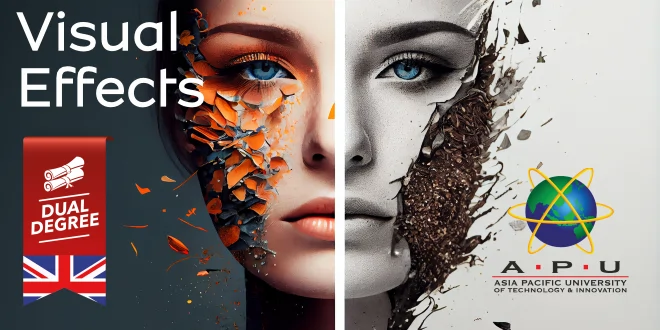APU BA in Visual Effects (VFX) is a study program where students learn how to make and add digital pictures and settings to different types of media. They learn both art ideas and how to use special computer programs. This program trains students to make looking or imaginary visuals that are usually added after the main work is done in movies, TV shows, video games, virtual reality, and more. After finishing, students can have many job choices, like VFX artist, someone who mixes videos (compositor), 3D shape creator (3D modeler), background artist (matte painter), effect creator (simulation artist), and someone who sets up lights (lighting technician), and more.
Program Description
APU BA in Visual Effects program can be incorporated into live scenes using methods such as matte artworks, projections from the back or front, small-scale or trick perspective sets, digital graphics for objects, people, and places, and merging variously captured images together. With the rising demand for computer-generated imagery (CGI), visual effects are becoming more widespread in our daily lives.
The VFX recognition is tailored for those aiming for jobs in the movie, post-editing, or gaming sectors. However, some might find opportunities in architectural design visualization, advertising enhancement agencies, or further academic studies. Primarily, VFX changes around creating and developing ideas for movies or games, including everything from characters and vehicles to outfits, backdrops, and settings, eventually bringing these concepts to life as finalized artwork or 3D representations.
Today, the movie and gaming sectors are in greater need of attracting storylines with corresponding characters, settings, and props. Students craft ideas, sometimes starting as 2D art sketches, enriched by precise 3D digital designs and merged with green screen techniques. Training includes design strategies, original concept creation, imaginative design, visualization techniques, life sketching, hand drawn sketches, and tangible model making to instill foundational design abilities.
Application Process
To be considered for admission into APU’s Design Degrees, every applicant must provide one of the following items for assessment, along with their full academic records:
- A Portfolio
- Participation in an Interview
Program Outline
The program aims to teach students with:
- Learn how to create and study designs used in movies and games.
- Understand how visual effects (VFX) make projects interesting and lively.
- Build skills to organize work better.
- Improve ways to talk and share ideas with others.
- Learn the important steps involved in making VFX for the industry.
Degree Level 1
In the first year of VFX, students will learn the basic skills. They will practice drawing and learn how to make quick sketches of ideas. They will also learn how thinking creatively can help in designing visuals and how doing research and studying can help in making a good concept. For the technical part, students will start with Digital Art and Drawing, making 3D shapes and models, and learning how to put different images together. Working well in a group, managing projects, and showing their work to others are also important things they will learn.
Common Courses
- Creative Project
- Illustration for Concept Art
- Cinema Film Analysis
- 3D Pipeline
- Fundamentals of Entrepreneurship
Specialized Courses
- Advance 3D Pipeline
- Digital Illustration
- Digital Compositing
- Motion Graphics
Degree Level 2
In the second year, the courses further build upon the students’ foundational abilities. Progressing from the first year, the focus shifts to enhancing their critical thinking and troubleshooting capabilities. Students explore advanced 3D design and image layering techniques using the latest software popular in the VFX world. Additionally, they are given the freedom to choose a special course that helps them become even better in their preferred area of study.
Common Courses
- From Script to Screen
- Digital Film Production
- Effects & Simulation
- Rigging for Animation
- Visual Culture
- Innovation Process
Specialized Courses
- Character Concept Design
- Advanced Digital Compositing
- Set Design
- Digital Sculpting
- CGI Production
Internship
To bridge the gap between academic and professional worlds, students will experience an Internship or Industrial Training for at least 16 weeks. This ensures they transition smoothly from academic settings to real world jobs.
Degree Level 3
During year 3, students apply what they have learned earlier to craft professional projects for their final year portfolio. They learn through the entire creation process, from presenting their initial ideas to the final stages of production, always under the watchful eyes of experienced mentors and industry leaders. Toward the end of the year, there is an event where students can display their work to industry insiders and potential employers, offering them a direct path to job opportunities.
Common Courses
- Sound Design
- Animation Techniques for Games
- Research Project Report
- Exhibition Design
- Venture Creation
- Design Futures
Specialized Courses
- Team VFX Project: Proposal
- Team VFX Project: Production
- VFX Project: Proposal
- VFX Project: Production
MQA Compulsory Subjects
- Appreciation of Ethics and Civilization (Malaysian Students)
- Malay Communication Language (Int’l Students)
- Philosophy and Current Issues
- Workplace Professional Skills
- Integrity and Anti-corruption
- Co-Curriculum
APU-DMU Dual Degree
Students enrolled in the Bachelor’s Degree Program are presented with the opportunity to join the APU-DMU Dual Degree Scheme. By choosing this pathway, upon graduation, students will be awarded two Degree Certificates & Transcripts: one from Asia Pacific University (APU) in Malaysia and another from De Montfort University (DMU) in the UK.
| Duration | Intakes |
| 3 Years (6 Semesters) |
14 Mar 2024 | 25 Jul 2024 24 Sep 2024 | 21 Nov 2024 |
Admission Requirements
| General Requirements | |
| Direct Entry to Level 1 of Degree | |
| STPM | • 2 Passes in A-Level. |
| A-Level | • 2 Passes in A-Level. |
| UEC | • 5 Grade B’s in UEC. |
| Foundation/ Matriculation | • A Pass in Matriculation or Foundation studies with minimum CGPA of 2.00. |
| Direct Entry to Level 2 of Degree | |
| Related Diploma | • A Diploma (Level 4, MQF) with a minimum CGPA of 2.00, or its equivalent • A pass in DKM / DLKM / DVM with a minimum CGPA of 2.50 subjected to HEP Senate/ Academic Board’s approval. |
| Portfolio | Note: Pass an Interview OR submission of Design Portfolio as required. |
English Requirements for International Students
- IELTS : 5.5
- TOEFL iBT : 46
- Pearson (PTE) : 54
- MUET : Band 4.0
Career Options
- 2D Artist
- Previs Artist
- 3D Generalist
- Modeller
- Lighting Artist
- Matchmove Artist
- Matte Painter
- Story Board Artist
- Rigger
- Animator
- Motion Graphics Artist
- Digital Compositor
- Producer
- Technical Director
- Concept Artist
- Roto Artist
- Texture Artist
- VFX Coordinator
- Creative Director
Course Fees
| Malaysian Students | International Students |
| Year 1: RM 28,400 | Year 1: RM 29,800 (USD 7,270) |
| Year 2: RM 28,800 | Year 2: RM 31,500 (USD 7,680) |
| Year 3: RM 29,800 | Year 3: RM 32,200 (USD 7,855) |
| Total: RM 87,000 | Total: RM 93,500 (USD 22,805) |
 SharifStudy Best way to Study in Malaysia
SharifStudy Best way to Study in Malaysia




